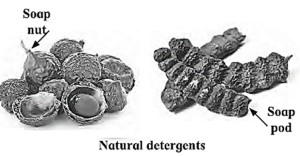Material We Use
Maharashtra Board-Class 7th-General Science-Chapter-15
Notes
|
Topics to be Learn:
|
Introduction : In olden days, acacia bark, neem twigs, coal powder, ash, tooth powder, salt, pomegranate rind and powder of shells were used to clean the teeth.
Now a days we use tooth paste and tooth powder, ayurvedic powder to clean the teeth.
Toothpaste : Calcium carbonate and calcium hydrogen phosphate are the principal ingredients of a toothpaste. They remove the dirt on teeth and polish them. Some proportion of flouride in the toothpaste is added to the toothpaste for preventing tooth decay.
- Fluoride is a naturally occurring element.
- It is present in all the water sources.
- In tooth powder and tooth paste the fluoride is added in the form of magnesium fluoride.
- It is absorbed in the covering of the teeth.
- Fluoride strengthens of bones and the enamel covering of teeth.
Detergents : A substance that cleans or wipes away dirt is called a detergent.
Properties of detergents : Examples : Soap nut (ritha), soap pod (shikekai), soap, washing soda, washing powder, liquid soap, shampoo.

Natural detergent : Natural substances containing chemical named saponin are called natural detergents. e.g., Soap nut (ritha) and soap pod (shikekai). They do not have any harmful effect on human skin or on silk and woollen threads and cloth.

Man-made detergent :
Soap : Man-made detergent which is used since ancient times is soap. Soap was invented about 2000 years ago in the west. That time, soap was made with animal fat and wood ash. Now there are many type of soaps.
Types of soaps :
| Hard Water : If the salts of calcium and magnesium such as bicarbonates, chlorides and sulphates are dissolved in the water, then there is hardness caused to the water. |
Synthetic detergent : Now synthetic detergents have taken the place of soap.
Cement : Cement is an important material in construction, Sand, limestone, cement, soil, mud, bricks etc. are the materials used for construction. Without cement a good construction cannot be made. Concrete produced from cement is used to manufacture sheets, blocks, pillars and pipes.
These days there is a very heavy traffic on the road. Therefore, there is need of strong roads that can support speedy transport. Therefore, nowadays, roads are made of concrete.
Cement production :
The dry, greenish grey powder of cement has fine particles. Cement is made from silica (sand), alumina (aluminium oxide), lime, iron oxide and magnesia (magnesium oxide).
Portland cement : The most commonly used cement for construction work which consists of From the Isle of Portland in England, the name Portland cement is given because the stone quarried from this area has a similar texture.
Aqueous cement : Aqueous cement and concrete was made by mixing volcanic ash in moistened lime by Romans in ancient times. This is very durable cement.
This process of making aqueous cement was forgotten. But in 1756, John Smeaton developed the method of making aqueous cement again.
Concrete : Concrete is prepared by mixing cement, water, sand and gravel. A strong and leak proof slabs are made by using certain other substances mixed with concrete.
| Main Page : Class 7th MSBSHSE – General Science - All chapters notes, solutions, videos, test, pdf.
Previous Chapter : Chapter 14 :Elements, Compounds and Mixtures - Online Notes Next Chapter : Chapter-16- Natural Resources- Online Notes |